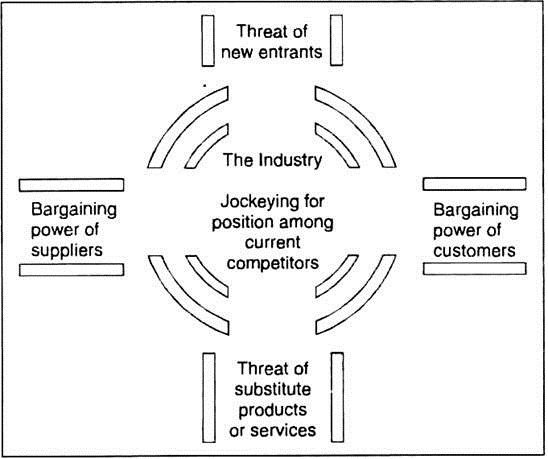The problem of determining competitive strategy of a firm is that of finding the right product-market-sales approach combination for effective accomplishment of its objectives in each field of endeavour specified in the organisation mission and deriving associated goals in the various functional areas of the business.
The choice of a particular strategy is possibly the most critical in the competitive arena. If a firm is not competitive, it will fail. If it is a superior competitor, it will succeed.
ADVERTISEMENTS:
ADVERTISEMENTS:
According to Michael E. Porter, the state of competition in an industry depends on five basic forces, as diagramed below:
The collective strength of these forces determines the ultimate profit potential of an industry. Knowledge of these underlying forces provides the groundwork for a strategic agenda of action.
ADVERTISEMENTS:
They highlight the critical strength and weaknesses of the company, clarify the areas where strategic changes may yield the greatest pay-offs, and highlight the places where industry trends promise to hold the greatest significance as either opportunities or threats. Understanding the sources of these forces also help in considering areas for diversification.
In his book Competitive Strategy:
Techniques for analysing industries and competitors’, Porter states that once the corporate strategist has assessed the forces affecting competition and their underlying causes, he can identify his company’s strengths and weaknesses from a strategic view-point.
ADVERTISEMENTS:
Then the strategist can devise a plan of action. Such plan of action may include:
1. Positioning the company so that its capabilities provide the best defence against the competitive force; and/or
2. Influencing the balance of the forces through strategic moves, thereby improving the company’s position, and/or
3. Anticipating shifts in the factors underlying these forces and responding to them, with the hope of exploiting change by choosing a strategy appropriate for the new competitive balance before opponents recognise it.
ADVERTISEMENTS:
In international business horizon, a novel way of strategy identification in the form of competitive strategy known by such names as entente, strategic alliance, coalition, etc. is seen to be adopted by some firms. This strategy seeks to enhance the long-term competitive advantage of the firm by forming alliances with its competitors, existing or potential, in critical areas, instead of competing with others.
In their article ‘Anatomy of Corporate Planning’, Gilmore and Brandenburg identified competitive strategy as an important component of corporate planning and gave the following model for formulation of competitive strategy.
Notes:
ADVERTISEMENTS:
(A) Product-market opportunities (characterised by the significant features that are expected to influence their outcomes) are specific combinations of product-market-sales approaches which define possible ways of exploiting a field of endeavour.
(B) Based on the information developed in the preceding three steps, an analysis may be made of the firm’s functional capabilities with respect to research and development, marketing, production, finance and management. Changes required for successful implementation of each alternative product-market opportunities may be defined as product-market plans.
(C) Combining the plans for the more attractive product-market opportunities with one another, or with existing plans in fields of endeavour in which the company is already operating, will serve to develop alternative strategies for the firm as a whole.
ADVERTISEMENTS:
(D) The decision as to the competitive strategy of the firm defines the directions in which the company will move towards its objectives in each environment included in the organisational mission. The particular ways in which performance objectives will be pursued in each field of endeavour, together with the functional goals necessary for their accomplishment, are specified-thus, providing the framework for development of a programme of action.

